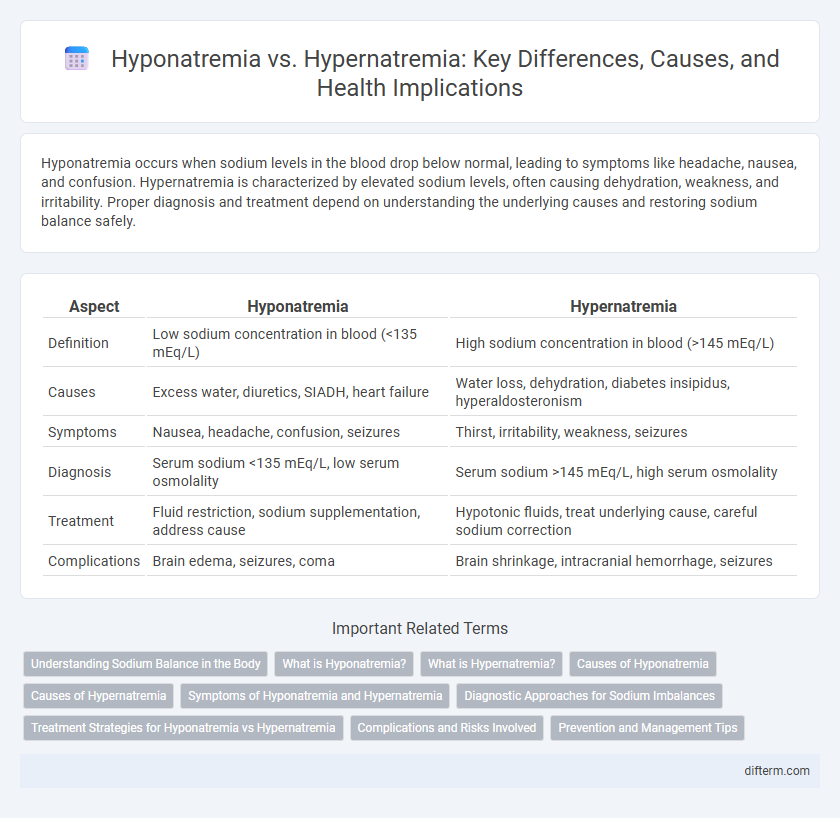Hyponatremia occurs when sodium levels in the blood drop below normal, leading to symptoms like headache, nausea, and confusion. Hypernatremia is characterized by elevated sodium levels, often causing dehydration, weakness, and irritability. Proper diagnosis and treatment depend on understanding the underlying causes and restoring sodium balance safely.
Table of Comparison
| Aspect | Hyponatremia | Hypernatremia |
|---|---|---|
| Definition | Low sodium concentration in blood (<135 mEq/L) | High sodium concentration in blood (>145 mEq/L) |
| Causes | Excess water, diuretics, SIADH, heart failure | Water loss, dehydration, diabetes insipidus, hyperaldosteronism |
| Symptoms | Nausea, headache, confusion, seizures | Thirst, irritability, weakness, seizures |
| Diagnosis | Serum sodium <135 mEq/L, low serum osmolality | Serum sodium >145 mEq/L, high serum osmolality |
| Treatment | Fluid restriction, sodium supplementation, address cause | Hypotonic fluids, treat underlying cause, careful sodium correction |
| Complications | Brain edema, seizures, coma | Brain shrinkage, intracranial hemorrhage, seizures |
Understanding Sodium Balance in the Body
Hyponatremia and hypernatremia represent imbalances in sodium concentration critical for maintaining cellular function and fluid homeostasis. Hyponatremia involves insufficient sodium levels in the blood, often leading to cellular swelling and neurological symptoms, whereas hypernatremia indicates excess sodium causing cellular dehydration and potential neurological damage. Effective regulation by the kidneys and hormones like aldosterone ensures sodium balance, essential for nerve impulse transmission and muscle contraction.
What is Hyponatremia?
Hyponatremia is a medical condition characterized by abnormally low sodium levels in the bloodstream, typically below 135 mEq/L, which disrupts cellular function and fluid balance. Common causes include excessive fluid intake, congestive heart failure, kidney disease, and certain medications that affect water and sodium retention. Symptoms range from mild nausea and headache to severe complications like seizures, confusion, and coma if left untreated.
What is Hypernatremia?
Hypernatremia is a condition characterized by an elevated sodium concentration in the blood, typically exceeding 145 mmol/L, resulting from water loss or excessive sodium intake. It often leads to cellular dehydration, neurological symptoms such as confusion, seizures, and muscle twitching. Treatment involves careful water replacement and addressing the underlying cause to restore sodium balance and prevent complications.
Causes of Hyponatremia
Hyponatremia is primarily caused by excessive water retention or sodium loss due to conditions such as heart failure, kidney disease, and syndrome of inappropriate antidiuretic hormone secretion (SIADH). Certain medications like diuretics and antidepressants also contribute to sodium imbalance by increasing renal sodium excretion. Inadequate dietary sodium intake or excessive fluid intake during endurance activities can further exacerbate hyponatremia risk.
Causes of Hypernatremia
Hypernatremia is primarily caused by water loss exceeding sodium loss due to dehydration, excessive sweating, or diuretic use. Another significant cause includes inadequate water intake, especially in the elderly or those with impaired thirst mechanisms. Conditions like diabetes insipidus and certain kidney disorders also contribute to elevated sodium levels in the blood.
Symptoms of Hyponatremia and Hypernatremia
Hyponatremia symptoms include headache, nausea, confusion, seizures, and muscle weakness due to low sodium levels causing cellular swelling. Hypernatremia presents with thirst, irritability, muscle twitching, lethargy, and seizures as high sodium concentration leads to cellular dehydration. Both conditions require prompt diagnosis to prevent severe neurological complications.
Diagnostic Approaches for Sodium Imbalances
Diagnostic approaches for sodium imbalances involve serum sodium measurements, with hyponatremia typically identified by levels below 135 mEq/L and hypernatremia above 145 mEq/L. Further evaluation includes assessing patient volume status, urine sodium concentration, and osmolality to determine the underlying cause. Advanced diagnostics may incorporate endocrine function tests and imaging studies to pinpoint related disorders such as SIADH or diabetes insipidus.
Treatment Strategies for Hyponatremia vs Hypernatremia
Treatment strategies for hyponatremia primarily involve careful sodium level correction using hypertonic saline in severe cases, alongside fluid restriction or addressing underlying causes such as heart failure or SIADH. Hypernatremia management centers on gradual rehydration with hypotonic fluids or oral water intake to avoid cerebral edema, while correcting any underlying causes like diabetes insipidus or excessive salt intake. Monitoring serum sodium and electrolyte balance closely prevents neurological complications during both treatments.
Complications and Risks Involved
Hyponatremia presents risks such as cerebral edema, seizures, and respiratory arrest due to low sodium levels causing cellular swelling, especially in the brain. Hypernatremia increases the risk of intracranial hemorrhage, lethargy, and irreversible neurological damage as elevated sodium levels lead to cellular dehydration. Both electrolyte imbalances require prompt medical intervention to prevent severe neurological complications and potential mortality.
Prevention and Management Tips
Effective prevention of hyponatremia and hypernatremia involves maintaining balanced sodium levels through proper hydration and dietary monitoring. Managing hyponatremia requires cautious fluid restriction and addressing underlying causes such as heart failure or kidney disease, while hypernatremia treatment focuses on gradual rehydration with isotonic or hypotonic fluids to avoid cerebral edema. Regular monitoring of serum sodium concentrations in at-risk patients ensures early detection and timely intervention, optimizing clinical outcomes.
Hyponatremia vs Hypernatremia Infographic

 difterm.com
difterm.com